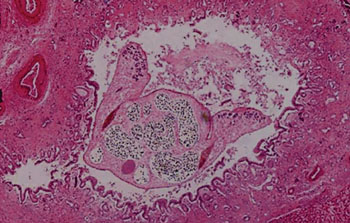Levels of 8-OxodG Predict Hepatobiliary Pathology in Opisthorchiasis
By LabMedica International staff writers
Posted on 20 Aug 2015
Opisthorchis viverrini is distinct among helminth infections as it drives a chronic inflammatory response in the intrahepatic bile duct that progresses from advanced periductal fibrosis (APF) to cholangiocarcinoma (CCA).Posted on 20 Aug 2015
Oxidative stress (OS) plays a critical role in the transition from chronic O. viverrini infection to CCA and also results in the excision of a modified DNA lesion 8-oxodG into urine, the levels of which can be detected by immunoassay.
Scientists at Khon Kaen University (Thailand) and an international team of collaborators, assigned 149 individuals to three groups; Group 1 were 23 individuals negative (uninfected) upon fecal examination for O. viverrini; Group 2 were 48 O. viverrini positive (OV+) individuals who were negative for APF; and Group 3 were 78 O. viverrini positive individuals who were also positive for APF. Group 4 consists of samples from 33 individuals who had histologically proven O. viverrini-associated CCA, whose urine samples had been stored.
Venous blood samples were collected from individuals in Groups 1, 2 and 3, into siliconized tubes after overnight fasting. Venous blood samples were allowed to clot at room temperature for 30 minutes after collection, centrifuged, and the serum recovered. An enzyme-linked immunosorbent assay (ELISA) was used to quantify levels of the antibody against O. viverrini antigen in serum. Concentration of 8-oxodG in urine was measured using a validated competitive ELISA kit (HT Trevigen, Gaithersburg, MD, USA). The ELISA plates were read using a SpectraMax 340PC384 microplate reader (Molecular Devices, Sunnydale, CA, USA).
Elevated concentrations of 8-oxodG in urine was positively associated with APF and CCA in a strongly dose-dependent manner. Urinary 8-oxodG concentrations also accurately predicted whether an individual presented with APF or CCA compared to O. viverrini infected individuals without these pathologies. Urinary 8-oxodG is a robust candidate biomarker of the progression of APF and CCA from chronic opisthorchiasis, which is indicative of the critical role that OS plays in both of these advanced hepatobiliary pathologies.
The authors confirmed their previous observations that severe liver pathology occurs early and asymptomatically in residents of O. viverrini endemic regions, where individuals are infected for years and often decades with this food-borne pathogen. These findings also contribute to an expanding literature on 8-oxodG in an easily accessible bodily fluid as in urine, as a biomarker in the multistage process of inflammation, fibrogenesis, and infection-induced cancer. O. viverrini is commonly known as the Southeast Asian liver fluke. The study was published on July 31, 2015, in the journal Public Library of Science Neglected Tropical Diseases.
Related Links:
Khon Kaen University
HT Trevigen
Molecular Devices















